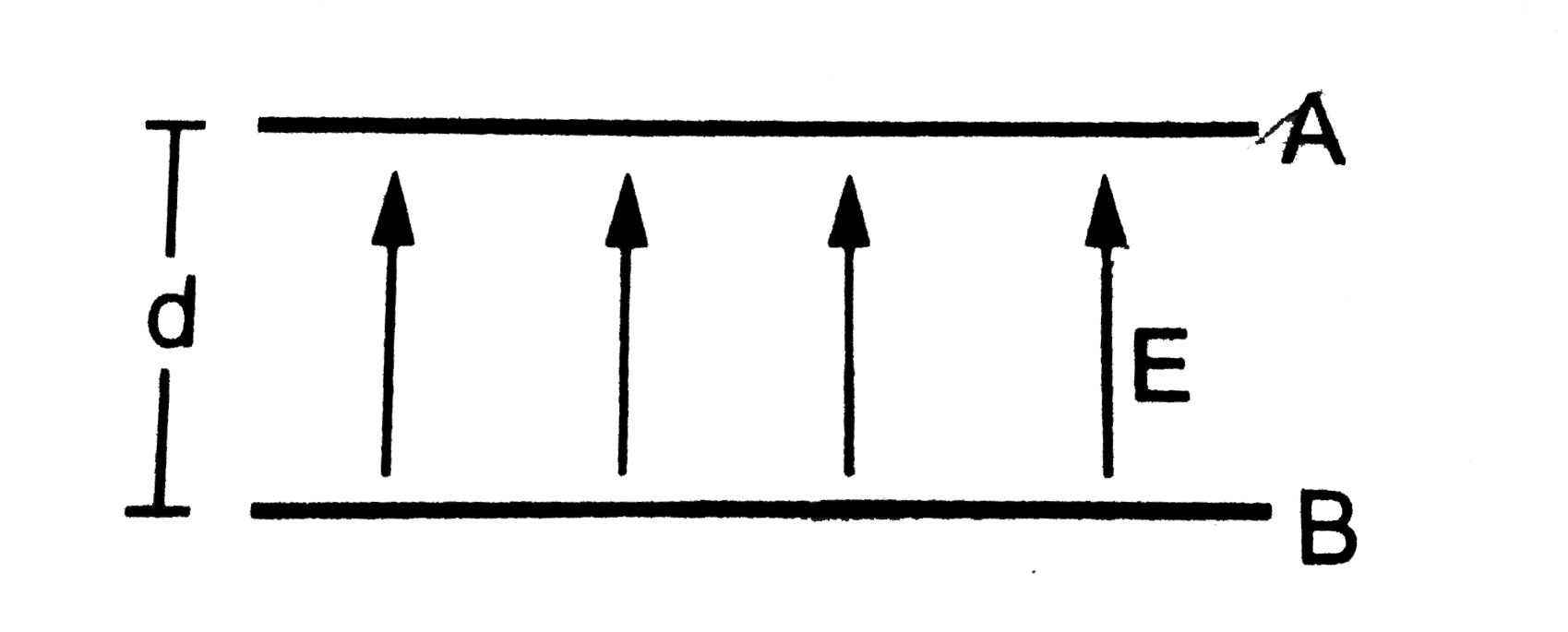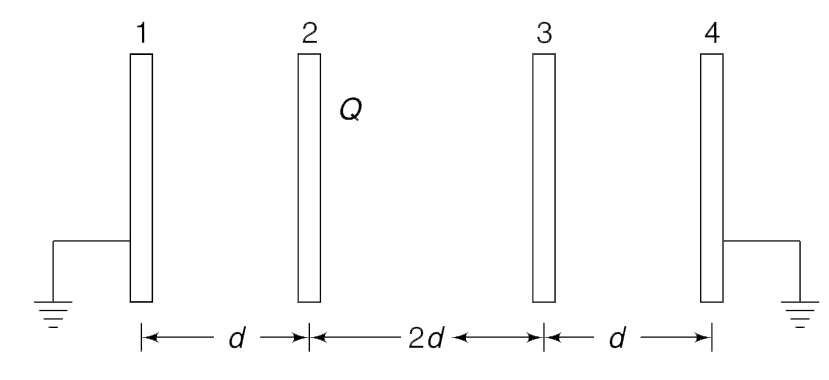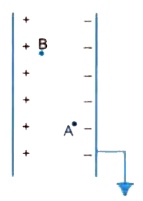Figure shows two metallic plates A and B placed parallel to each other at a seperation d. A uniform electric field E exists between the plates in the direction from plate B to plate A. Find the potential difference between the plates.
 Solution in Tamil
Solution in Tamil
Let us take the origin at plate a and x-axis
along the direction from plate A to plate B. We have
VB−VA=−∫rBrA→Ed→r=−∫d0−Edx=Ed.<br>ifwework∈Cartesianc∞rd∈atesystem<br>E = E_x veci +E_y vec j +E_z veck<br>anddvecr = dx veci +dy vecj +dz veck.<br>Thusom<br>dV = E_x dx- E_y dy-Ez dz. (i)<br>Ifwechan≥x→x+dxkeeπngyandzconstant,<br>dy=dz=0andom(i),<br>|(E_x=-(delV)/(delx)),(E_y=-(delV)/(dely)),(E_z = -(delV)/(delz))|<br>Thesymbols(del)/(delx), (del)/(dely)ect.areused→∈dicatetˆ<br>whi≤d⇔erentiat∈gwithrespect→o≠c∞rd∈ate,theotherarekeptconstant.<br>ifweknowthee≤ctricfield∈aregion,wecan<br>f∈dthee≤ctricusingequationand<br>ifweknowthee≤ctr∈cpotential∈aretgion,wecanf∈dthee≤ctricfieldusing<br>Equationmayalsobewrienas<br>dV = -E dr cos theta<br>Wherethetaisthe∠betweenthefieldvecEandthesmall<br>displacementdvecr.Thus.<br>-(dV)/(dr) = E cos theta<br><imga≤ocr_imageload∈g=lazysrc=https://d10lpgp6xz60nq.cloudfront.net/physics_images/HCV_VOL2_C29_S01_005_S01.pngwh=80%mx-autosty≤=background:white;>Weseetˆ,-(dV)/(dr)givesthecomp≠ntofthee≤ctric<br>field∈thedirectionofdisplacementdvecr.InweshowasmalldisplacementPP'=dr.Thee≤ctricfield<br>isEmak∈gan∠thetawithPP.'wehave<br>dV = V(P,) - V(P)<br>sotˆ(V(P) - V(P))/(dr) = E cos theta.<br>Thisgivesusamethod→≥tthecompo≠ntfo<br>thee≤ctricfield∈anygivendirectionifweknowthe<br>potential.MOveasmalldistancedr∈thegiven<br>directionandseethechan≥dV∈thepotential.The<br>compo≠ntofe≤ctricfieldalongtˆdirectionis<br>(dV)/(dr).<br>Ifwemoveadistancedr∈thedirectionofthe<br>field,thetaiszeroand -(dV)/(dr) = Eismaxiμm.Thusthe<br>e≤ctricfieldisalongthedirection∈whichthepotentialdecreaseatthemaxiμmrate.<br>Ifamalldisplacementdvecrperpendica––r→the<br>e≤ctricfieldisconsred,theta = 90^@and<br>dV = -vecE.dvecr = -0. The potential does not vary in a
direction perpendicular to the electric field.
Topper's Solved these Questions
- BOOK - HC VERMACHAPTER - ELECTRIC FIELD AND POTENTIALEXERCISE - worked out Examples19videos
ELECTRIC FIELD AND POTENTIAL
- BOOK - HC VERMACHAPTER - ELECTRIC FIELD AND POTENTIALEXERCISE - question for short answer14videos
ELECTRIC FIELD AND POTENTIAL
- BOOK - HC VERMACHAPTER - ELECTRIC CURRENT THROUGH GASESEXERCISE - Exercise23videos
ELECTRIC CURRENT THROUGH GASES
- BOOK - HC VERMACHAPTER - ELECTROMAGNETIC INDUCTIONEXERCISE - EXERCISE98videos
ELECTROMAGNETIC INDUCTION
Similar Questions
Charges 5.0×10−7C,−2.5×10−7Cand1.0×10−7C are
held fixed at the three corners A, B, C of equilateral triangle of side 10cm respectively. Find the electric force on the charge at C due to the rest two.01:59View SolutionThe charge on a proton is +1.6X10(−19)C and that on an
. electron is −1.6X10(−19)C. Does it mean that the electron
. has a charge 3.2X10(−19)c less than the charge of a
. proton?08:40View SolutionA discharge tube contains helium at a low pressure. A large potential difference is applied across the tube. Consider a helium atom that has just been ionized due to the detachment of an atomic electron. Find the ratio of the distance travelled by the free electron to that by the positive ion in a short time dt after the ionization.
02:16View SolutionCalculate the dimensions of (a) ∫→E.d→l,(b)vBlanddΦ0dt. The symbols have their usual meanings.
06:30View SolutionFigure shows a parallel plate capacitor with plate area A and plate separation d . A potential difference is being applied between the plates. The battery is then disconnected and a dielectric slab of dieletric constant K is placed in between the plates of the capacitor as shown. The electric field in the gaps between the plates and the electric slab will be
03:00View SolutionFour large identical metallic plates are placed as shown in the Figure. Plate 2 is given a charge Q. All other plates are neutral. Now plates 1 and 4 are earthed. Area of each plate is A.
(a) Find charge appearing on right side of plate 3.
(b) Find potential difference between plates 1 and 2.
 03:15View Solution
03:15View SolutionThe' distance between the plates of a parallel plate capacitor is d . A metal plate of thickness d//2 is placed between the plates. What will e its effect on the capacitance.
01:44View Solutionकिसी समान्तर पट्टिका वायु संधारित्र की सुचालक प्लेटों को क्रमशः Q1 तथा Q2 आवेश दिए गए हैं। यदि प्लेटों का क्षेत्रफल A तथा उनके बीच की दूरी d हो, निम्नलिखित के मान ज्ञात करें-
(a) प्लेटों के बीच एकसमान विद्युत-क्षेत्र की प्रबलता,
(b) प्लेटों के बीच विभवांतर, तथा
(c) प्लेटों के बीच निहित स्थिर-विद्युतीय ऊर्जा।View Solutionएक समान्तर प्लेट संधारित्र की प्लेटों के बीच दूरी d तथा प्लेटों के क्षेत्रफल A के बीच क्षेत्र में एकसमान विद्युत क्षेत्र E है। इस आवेश संधारित्र की ऊर्जा है -
02:14View SolutionA parallel plate air filled capacitor having area 40cm2 and plate spacing 1.0 mm is charged to a potential difference of 500V. Find (a) the capacitance, (b) the magnitude of the charge on each plate ( c) the stored energy, (d) the electric field between the plates and (e ) the energy density between the plates.
03:56View Solutionदो समान्तर प्लेटों के विभव क्रमशः -10V एवं +30V हैं | यदि प्लेटों के बीच की दूरी 2cm हो | तो प्लेटों के मध्य विद्युत क्षेत्र होगा
02:16View SolutionIn a parallel plate capacitor the potential difference of 100 V is manitianed between the plates. If distance between the plates be 5mm, what will be the electric field at points A and B ?
 View Solution
View SolutionFigure shows a parallel plate capacitor with plate area A and plate separation d . A potential difference is being applied between the plates. The battery is then disconnected and a dielectric slab of dieletric constant K is placed in between the plates of the capacitor as shown. The electric field in the gaps between the plates and the electric slab will be
03:13View SolutionFour large identical metallic plates are placed as shown in the Figure. Plate 2 is given a charge Q. All other plates are neutral. Now plates 1 and 4 are earthed. Area of each plate is A. (a) Find charge appearing on right side of plate 3. (b) Find potential difference between plates 1 and 2.
03:13View SolutionThe' distance between the plates of a parallel plate capacitor is d . A metal plate of thickness d//2 is placed between the plates. What will e its effect on the capacitance.
43:38View SolutionThe electric field between two plates of a parallel plate capacitor is non-uniform
02:31View Solution

